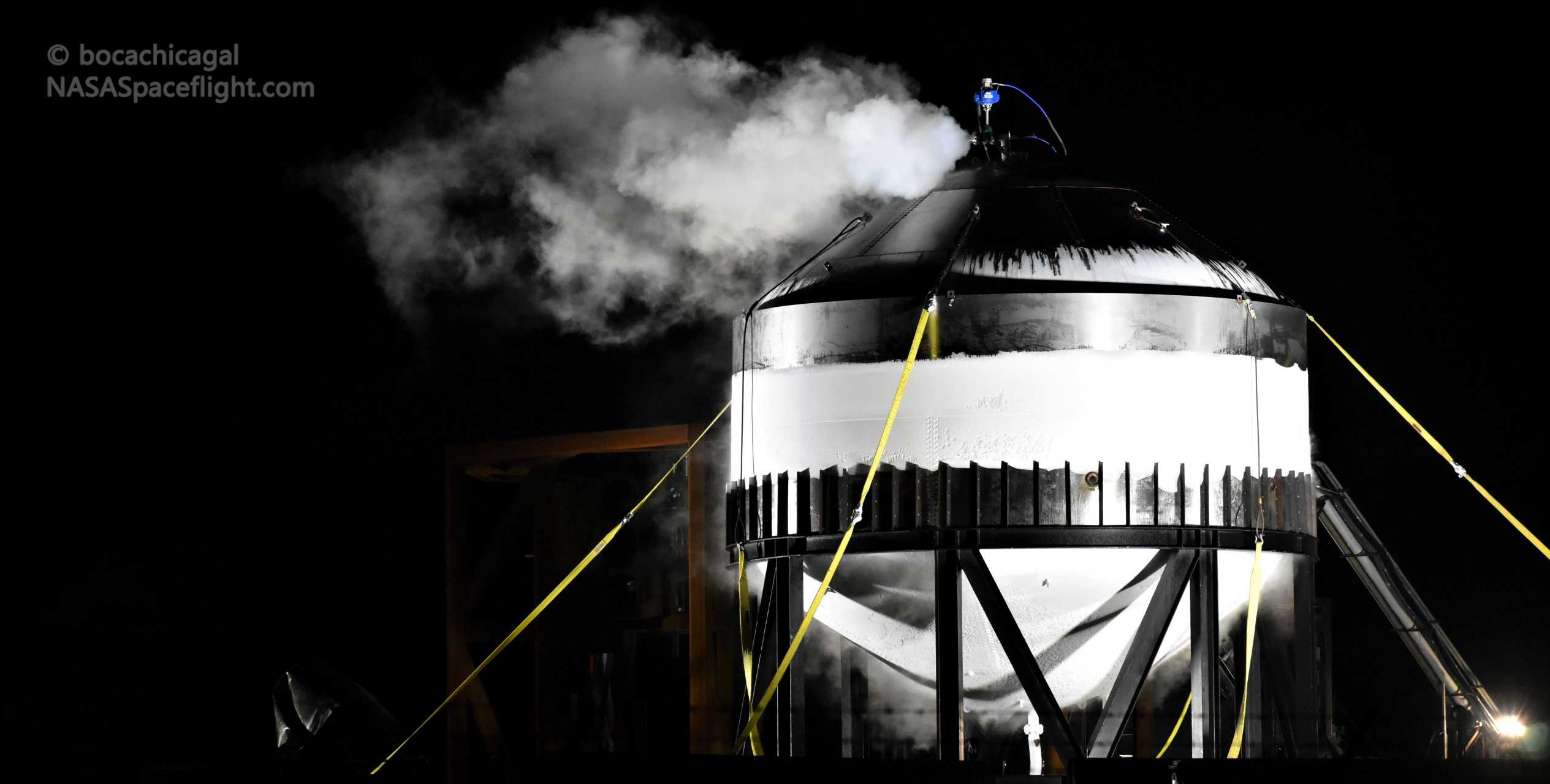
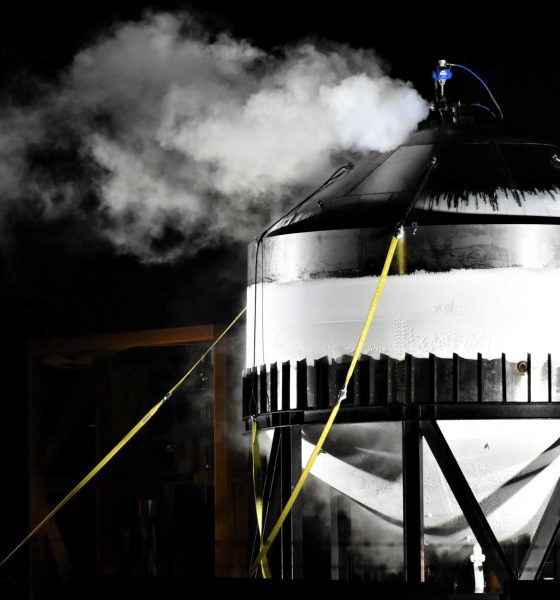
News
SpaceX Starship just aced another explosive tank test and Elon Musk has the results [video]
SpaceX has successfully repaired a leak in a Starship prototype, filled the giant tank with an ultra-cold liquid, and pressurized it until it (spectacularly) popped — and Elon Musk has the preliminary results.
Designed to determine the quality and capabilities of SpaceX’s current manufacturing and integration procedures, the company technically performed its first explosive Starship test back in November 2019, when it decided that the first full-scale prototype – Starship Mk1 – was not fit to fly. Instead of entering the final stages of assembly with a vehicle that SpaceX simply couldn’t be sure would survive the rigors of even a low-stress flight test, the massive vehicle’s tank section was installed at the company’s South Texas launch facilities and pressurized with liquid nitrogen until it burst.
Built almost entirely unprotected on the South Texas coast, Starship Mk1 simply wasn’t up to the standards needed for SpaceX to trust that the giant rocket would survive the stresses of flight. Much like Falcon 9, Starship and its Super Heavy booster will be structurally stable while their tanks are empty, but a great deal of additional (and absolutely critical) structural strength will be added by pressurizing those tanks with a combination of liquid and gaseous propellant. Achieving the required pressures, however, can be a major challenge and the purpose of test tanks like the one above is to prove that the company is up to the challenge. According to Elon Musk, after tonight’s test, SpaceX almost certainly is.
In all truthfulness, the real start of explosive Starship pressure testing actually happened all the way back in 2017 when SpaceX intentionally pressurized a vast 12m-diameter (40 ft) carbon composite tank until it popped. Back then, Starship was known as Big Falcon Rocket (BFR) and was designed to use carbon fiber composites for nearly all of its structure — propellant tanks included.
According to CEO Elon Musk, said carbon composite tank met SpaceX’s expectations (i.e. the necessary pressures for flight) and was pushed to 2.3 bar (33 psi) before it burst in a rather spectacular fashion, launching almost 100 m (300 ft) into the air. Around 2.5 years after that test, it’s believed that Starship Mk1 reached something like 3-5 bar before it popped, and Musk recently revealed that the new steel Starship and Super Heavy designs will require tanks pressures of at least 6 bar (90 psi) to survive the stresses of orbital flight.
Thankfully, although Starship Mk1 didn’t achieve those necessary pressures, the prototype was effectively a worst-case scenario for manufacturing and assembly, revealing the rather unsurprising reality that SpaceX needed to improve its uniquely sparse methods of production and assembly. Although the stainless steel SpaceX settled on for Starship is much more tolerant than aluminum or most other metals when it comes to welding, steel welds still suffer if exposed to more than a minor breeze, as wind will cause the welded metal to cool less than uniformly.
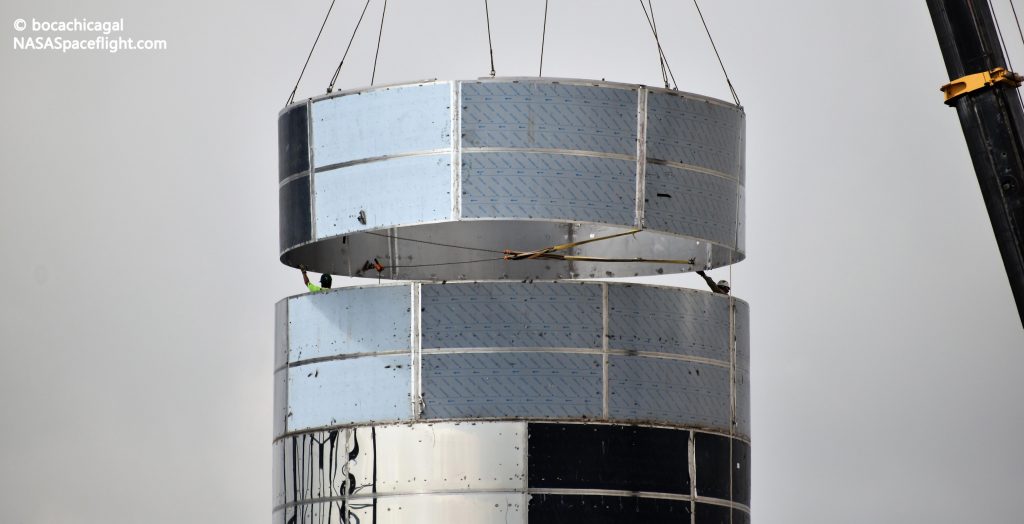
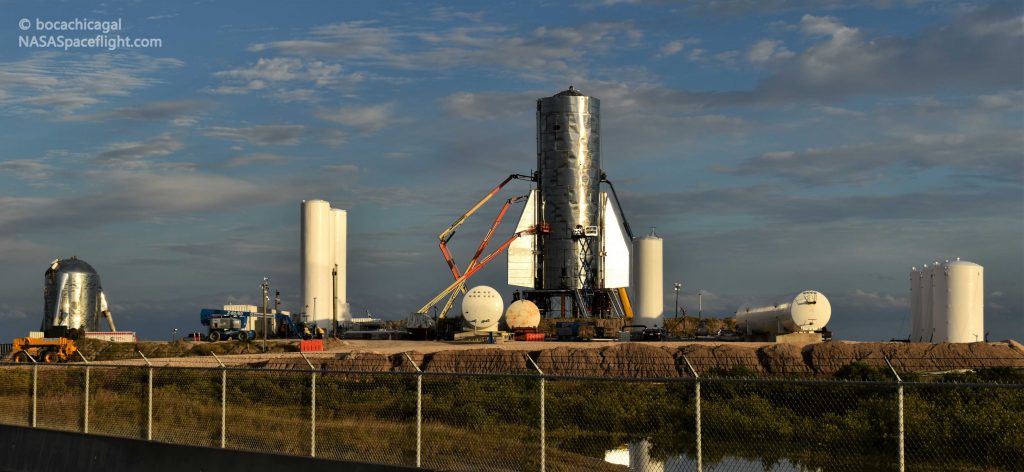
With the latest series of steel Starship tank prototypes, SpaceX has significantly improved its production infrastructure, finally offering at least a semblance of protection against the elements. Based on the first test tank’s explosive performance on January 10th, those improvements have paid dividends. According to Musk, test tank #1 made it all the way to 7.1 bar (105 psi) before it burst and test tank #2 reportedly did even better.
Meanwhile, SpaceX’s South Texas team has already finished and partially tested a second Starship test tank, ultimately reaching 7.5 bar with water before a small leak sprung on January 27th. Over the last 24 hours, technicians have worked to repair the apparently minor damage and began filling the Starship tank with ultra-cold liquid nitrogen (boiling point: -196°C / -320°F) around 5:30 pm CST (23:30 UTC) on January 28th. After filling with liquid nitrogen, SpaceX kept the steel tank topped off for several hours. The likely purpose behind that otherwise odd move: something called cryogenic hardening. By exposing certain types of steel to liquid nitrogen temperatures, the material can be dramatically strengthened in some regards.
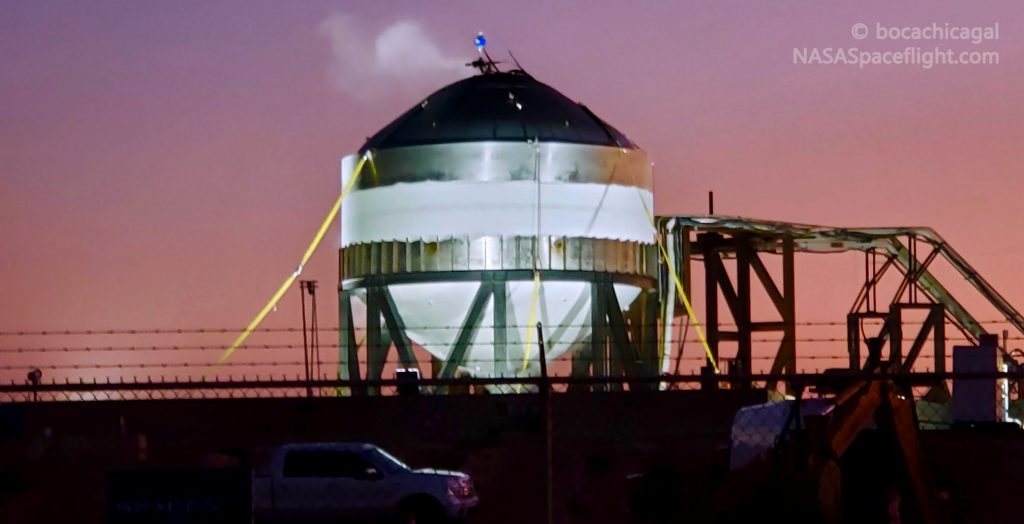
Around four hours after Tuesday evening’s testing began, the Starship tank prototype appeared to develop a significant leak in its upper dome, hemorrhaging liquid nitrogen that immediately produced large clouds after coming into contact with the South Texas air. As it turns out, whatever was observed was almost certainly not a leak: 30 or so minutes later, the tank was pressurized to failure, releasing a spectacular tidal wave of liquid nitrogen that doused the surrounding area, temporarily killing nearby floodlights and creating a near-zero-visibility storm of fog.
We’ll have to wait for dawn tomorrow to see the extent of the damage, but it appears that Test Tank #2’s demise was dramatically more violent than its predecessor — a largely expected side effect of performing the pressure test with a cryogenic liquid. In fact, just minutes after it appeared to fail, Elon Musk revealed that the second test tank had burst around 8.5 bar (~125 psi), soundly trouncing all records set by earlier tests and suggesting SpaceX is unequivocally ready to begin building the first orbital Starships. Critically, Musk had previously indicated that if Starship’s tanks could survive up to 8.5 bar, SpaceX would have the minimum safety margins it needs to deem Starship safe enough for astronauts.
In other words, if Test Tank #2 really did reach 8.5 bar, SpaceX has effectively solved the biggest structural engineering challenge its Starship program faces, kicking the doors wide open for the more or less immediate mass-production of the first giant orbital-class spacecraft. As it turns out, what Musk has deemed as the first “orbital” Starship prototype – ‘SN01’ – is already under construction, and it’s safe to say that any lessons learned from January 28th’s cryogenic pressure test will be fed back into SN01 and all future prototypes.
Check out Teslarati’s Marketplace! We offer Tesla accessories, including for the Tesla Cybertruck and Tesla Model 3.

Elon Musk
Elon Musk’s X will start using a Tesla-like software update strategy
The initiative seems designed to accelerate updates to the social media platform, while maintaining maximum transparency.

Elon Musk’s social media platform X will adopt a Tesla-esque approach to software updates for its algorithm.
The initiative seems designed to accelerate updates to the social media platform, while maintaining maximum transparency.
X’s updates to its updates
As per Musk in a post on X, the social media company will be making a new algorithm to determine what organic and advertising posts are recommended to users. These updates would then be repeated every four weeks.
“We will make the new 𝕏 algorithm, including all code used to determine what organic and advertising posts are recommended to users, open source in 7 days. This will be repeated every 4 weeks, with comprehensive developer notes, to help you understand what changed,” Musk wrote in his post.
The initiative somewhat mirrors Tesla’s over-the-air update model, where vehicle software is regularly refined and pushed to users with detailed release notes. This should allow users to better understand the details of X’s every update and foster a healthy feedback loop for the social media platform.
xAI and X
X, formerly Twitter, has been acquired by Elon Musk’s artificial intelligence startup, xAI last year. Since then, xAI has seen a rapid rise in valuation. Following the company’s the company’s upsized $20 billion Series E funding round, estimates now suggest that xAI is worth tens about $230 to $235 billion. That’s several times larger than Tesla when Elon Musk received his controversial 2018 CEO Performance Award.
As per xAI, the Series E funding round attracted a diverse group of investors, including Valor Equity Partners, Stepstone Group, Fidelity Management & Research Company, Qatar Investment Authority, MGX, and Baron Capital Group, among others. Strategic partners NVIDIA and Cisco Investments also continued support for building the world’s largest GPU clusters.
News
Tesla FSD Supervised wins MotorTrend’s Best Driver Assistance Award
The decision marks a notable reversal for the publication from prior years, with judges citing major real-world improvements that pushed Tesla’s latest FSD software ahead of every competing ADAS system.

Tesla’s Full Self-Driving (Supervised) system has been named the best driver-assistance technology on the market, earning top honors at the 2026 MotorTrend Best Tech Awards.
The decision marks a notable reversal for the publication from prior years, with judges citing major real-world improvements that pushed Tesla’s latest FSD software ahead of every competing ADAS system. And it wasn’t even close.
MotorTrend reverses course
MotorTrend awarded Tesla FSD (Supervised) its 2026 Best Tech Driver Assistance title after extensive testing of the latest v14 software. The publication acknowledged that it had previously criticized earlier versions of FSD for erratic behavior and near-miss incidents, ultimately favoring rivals such as GM’s Super Cruise in earlier evaluations.
According to MotorTrend, the newest iteration of FSD resolved many of those shortcomings. Testers said v14 showed far smoother behavior in complex urban scenarios, including unprotected left turns, traffic circles, emergency vehicles, and dense city streets. While the system still requires constant driver supervision, judges concluded that no other advanced driver-assistance system currently matches its breadth of capability.
Unlike rival systems that rely on combinations of cameras, radar, lidar, and mapped highways, Tesla’s FSD operates using a camera-only approach and is capable of driving on city streets, rural roads, and freeways. MotorTrend stated that pure utility, the ability to handle nearly all road types, ultimately separated FSD from competitors like Ford BlueCruise, GM Super Cruise, and BMW’s Highway Assistant.
High cost and high capability
MotorTrend also addressed FSD’s pricing, which remains significantly higher than rival systems. Tesla currently charges $8,000 for a one-time purchase or $99 per month for a subscription, compared with far lower upfront and subscription costs from other automakers. The publication noted that the premium is justified given FSD’s unmatched scope and continuous software evolution.
Safety remained a central focus of the evaluation. While testers reported collision-free operation over thousands of miles, they noted ongoing concerns around FSD’s configurable driving modes, including options that allow aggressive driving and speeds beyond posted limits. MotorTrend emphasized that, like all Level 2 systems, FSD still depends on a fully attentive human driver at all times.
Despite those caveats, the publication concluded that Tesla’s rapid software progress fundamentally reshaped the competitive landscape. For drivers seeking the most capable hands-on driver-assistance system available today, MotorTrend concluded Tesla FSD (Supervised) now stands alone at the top.
News
Elon Musk’s Grokipedia surges to 5.6M articles, almost 79% of English Wikipedia
The explosive growth marks a major milestone for the AI-powered online encyclopedia, which was launched by Elon Musk’s xAI just months ago.

Elon Musk’s Grokipedia has grown to an impressive 5,615,201 articles as of today, closing in on 79% of the English Wikipedia’s current total of 7,119,376 articles.
The explosive growth marks a major milestone for the AI-powered online encyclopedia, which was launched by Elon Musk’s xAI just months ago. Needless to say, it would only be a matter of time before Grokipedia exceeds English Wikipedia in sheer volume.
Grokipedia’s rapid growth
xAI’s vision for Grokipedia emphasizes neutrality, while Grok’s reasoning capabilities allow for fast drafting and fact-checking. When Elon Musk announced the initiative in late September 2025, he noted that Grokipedia would be an improvement to Wikipedia because it would be designed to avoid bias.
At the time, Musk noted that Grokipedia “is a necessary step towards the xAI goal of understanding the Universe.”
Grokipedia was launched in late October, and while xAI was careful to list it only as Version 0.1 at the time, the online encyclopedia immediately earned praise. Wikipedia co-founder Larry Sanger highlighted the project’s innovative approach, noting how it leverages AI to fill knowledge gaps and enable rapid updates. Netizens also observed how Grokipedia tends to present articles in a more objective manner compared to Wikipedia, which is edited by humans.
Elon Musk’s ambitious plans
With 5,615,201 total articles, Grokipedia has now grown to almost 79% of English Wikipedia’s article base. This is incredibly quick, though Grokipedia remains text-only for now. xAI, for its part, has now updated the online encyclopedia’s iteration to v0.2.
Elon Musk has shared bold ideas for Grokipedia, including sending a record of the entire knowledge base to space as part of xAI’s mission to preserve and expand human understanding. At some point, Musk stated that Grokipedia will be renamed to Encyclopedia Galactica, and it will be sent to the cosmos.
“When Grokipedia is good enough (long way to go), we will change the name to Encyclopedia Galactica. It will be an open source distillation of all knowledge, including audio, images and video. Join xAI to help build the sci-fi version of the Library of Alexandria!” Musk wrote, adding in a later post that “Copies will be etched in stone and sent to the Moon, Mars and beyond. This time, it will not be lost.”








